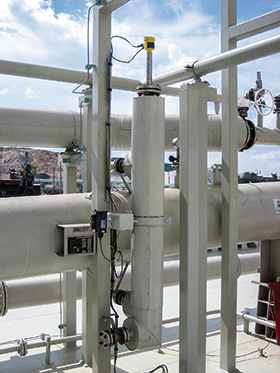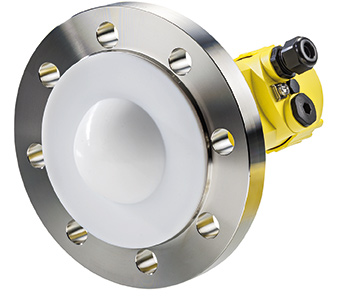

Level measurement in LNG and LPG processes is about answering the simple question: “How much product is in the tank?” However, obtaining an exact value is not easy. The products are often under pressure, cryogenic, and highly explosive. Sensors from Vega have been operating successfully in all stages of the LNG/LPG process for many years.
Throughout the production stages, from liquefaction, storage, shipping, vapouriser and pipeline, to further processing in the petrochemical or chemical industries, or consumption as an energy carrier, there are numerous measuring points where safe, reliable level measurement is required; but the installation situation and process conditions present significant obstacles to reliable measurement, and the unusual properties of the product do not make the task any easier.
Challenging product
LNG has a low density and an extremely low dielectric constant. These physical properties vary, so many measuring principles cannot give reliable, precise measurement. In addition, mechanical measuring techniques often malfunction and are maintenance-intensive at very low temperatures. Radar level sensors are the preferred measuring device, and have largely replaced previous measuring principles such as electromechanical sounding, differential pressure and ultrasonics. Vega has already installed more than 500 000 radar sensors worldwide, many of them in LNG/LPG applications.

Tricky internal fixtures
The new Vegapuls 80-GHz radar sensor allows a focusing of the radar beam that is more than three times better than previous radar level instruments. The narrow measuring beam simply flies past internal tank components. Thanks to its advanced focusing/signal bundling, the Vegapuls can be mounted directly on a tank without a standpipe. This makes measurement more reliable and accurate.
The Vegapuls is also suitable for poorly reflective media, i.e., liquids with low dielectric values, which are common in these industries. Vegapuls has an exceptionally large dynamic range. The greater the dynamic range of a radar sensor, the wider the application range, and the higher the measurement certainty. Larger signals automatically lead to better measurement. This means that media with poor reflective properties can now be measured much better than before.

Problem: ball valve
A strict requirement in industry is that every sensor must be separable from the process by means of a fitting, without interrupting the process. This is mandatory for liquid gas tanks on land. For a radar sensor, this previously meant that it had to be mounted on a ball valve to guarantee that it could be separated from the process during operation. The intention was to increase availability, but it often had the opposite effect. Production systems became more maintenance friendly, but also more maintenance intensive. Installation on a ball valve was never recommended for radar sensors because the ball valve itself caused large interfering reflections in the close range. Reliable measurement was impossible, especially in liquids with low dielectric values.
With Vegapuls, the influence of the ball valve is much smaller because of the considerably better signal focusing, and, as a result, the ball valve generates almost no disturbing signals. Interfering signals in the close range are thus avoided, and reliable measurement is ensured. Another advantage is that the new sensor can be installed on existing shut-off devices. This keeps rebuilding and retrofitting costs to a minimum. Critical applications can be easily upgraded to the new 80-GHz technology, thereby increasing plant availability and reducing maintenance requirements. When the echo curves of a 26-GHz sensor and a Vegapuls are compared in the same application, even experts are impressed. With smaller horizontal LPG tanks there is a further advantage. Bypass tubes are often used in these round tanks, but Vegapuls can be installed directly on the tank without a bypass tube. This saves additional costs.
Better utilisation of tank volume
The 80-GHz technology has a positive effect, especially when measuring liquids with low dielectric values at the bottom of the vessel. Normally, radar signals are reflected at the surface of the medium. In the case of media with small dielectric values, however, some of the signals penetrate the medium and are then reflected by the underlying container bottom. As a result, two signals are received: one from the liquid surface and one from the tank bottom. The lower the dielectric value of the medium and the lower the level, the larger the signal from the tank bottom. With the previous 26-GHz sensors, these two signals overlapped and mixed together, especially at low levels with only a few cm of filling height. The smaller level signal was practically swallowed by the larger bottom signal. For the radar sensor, the level signal was no longer visible. Due to the significantly shorter wavelength of the 80-GHz signals from Vegapuls, the signals that pass through the medium are more strongly attenuated by the medium than those emitted by 26-GHz sensors. As a result, the reflection from the bottom of the vessel is significantly weaker. Even at low levels, the level signal is much stronger than the bottom signal. The result is that even the lowest filling levels of a few millimetres can still be measured reliably and accurately. Processes can be further optimised and liquids reliably measured even at the bottom of large-volume containers. In other words, the tank volume can be utilised better.
Reliable limit level detection
LNG processes require not only continuous level measurement but also point level detection at many points. Vegaswing 66 is often chosen for this task. In general, vibrating level switches are very popular among users in the chemical and petrochemical industries, and in refineries because they are extremely easy to operate and ensure safe, reliable measurement. In contrast to float systems, Vegaswing 66 offers a much higher level of security, as the sensor constantly performs self-diagnosis and monitors the sensing element. This is why Vegaswing 66 is preferred over flotation devices in safety-critical applications.
However, until two years ago it was not possible to use these devices at very low temperatures. For these applications Vega developed a patented inductive drive that excites the tuning fork effortlessly even under extreme temperature conditions. The user benefits greatly with the simple handling of this vibrating level switch, with its extended application range down to -196°C (normal temperature in the LNG environment) and pressure range of -1 to 160 bar. Because the sensor measures so reliably irrespective of density, no matter what the product, it is perfect for high alarms. It is used, for example, in the pump pit of a liquefaction terminal. To keep the pump from running dry, it must always be covered with liquid LNG. Vegaswing 66 takes over level control here, ensuring reliable pump operation.
Conclusion
There is hardly any process in the LNG/LPG industry that does not require pressure measurement, continuous level measurement or point level detection. Thanks to the plics concept, Vega sensors have the advantage that the user interface is the same for every measuring instrument, regardless of the measuring method. Even users with little experience in instrumentation can quickly find their way around. The sensors have become even easier to operate through the combination of Plicscom and Bluetooth. Their wireless Bluetooth communication is particularly useful for hard to reach areas, harsh industrial environments, and Ex hazardous areas. The modular plics concept, which VEGA introduced more than 14 years ago, really shows its strengths here. Plicscom is backward compatible, and can be used for the entire installed base of plics sensors. This is even in pressure and level applications, with 70 different types of instruments. The service-proven adjustment structure means that no software update is required. This allows the user to configure and parameterise plics sensors conveniently from a safe distance, with a smartphone or tablet.
| Tel: | +27 11 795 3249 |
| Email: | [email protected] |
| www: | www.vega.com/en/home_za |
| Articles: | More information and articles about VEGA Controls SA |

© Technews Publishing (Pty) Ltd | All Rights Reserved